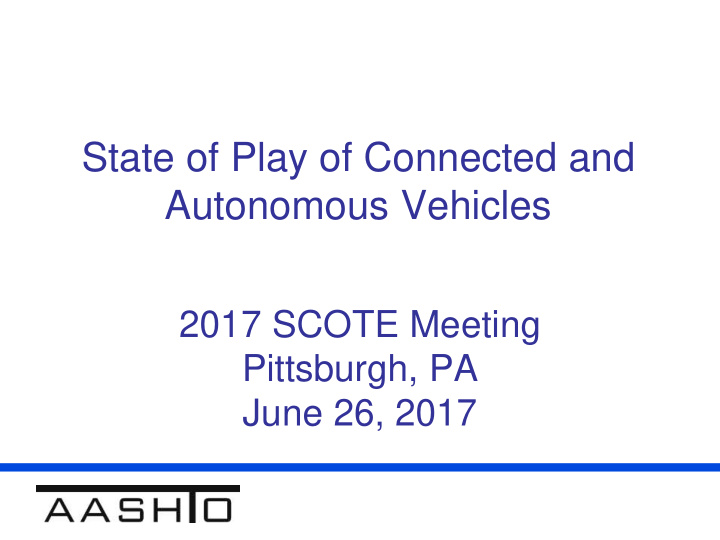



State of Play of Connected and Autonomous Vehicles 2017 SCOTE Meeting Pittsburgh, PA June 26, 2017
Panel Theme • 2 Part Panel Session Part 1 (June 26 th ) is designed to provide an update on ongoing CAV Activities related to Public Sector Initiatives Part 2 (June 27 th ) will focus on the private sector perspectives including technology advancements in CAV activities to meet V2V and V2I needs of suppliers and services including Cybersecurity, regulations, testing, etc. 2
National CAV Efforts • 2016 CAV Policy • 2016 NHTSA V2I NPRM • AASHTO, ITE and ITSA jointly led V2IDC SPaT Challenge • USDOT CV Pilots – WY; THEA, FL; and NY • FCC 2016 DSRC NPRM • Google, Uber, Lyft, etc. w/ active CAV programs • Several States are in the process or already have CAV related Legislative, Regulative and Policy frameworks in place 3
2017 AASHTO Automated Vehicle Public Policy Roundtable The roundtable held in-conjuction with the 2017 SAE Auto show had three overall goals: • Inform association participants of AV developments • Spur thinking on the part of public agency associations and their members • Explore possible public policy issues for cross- association collaboration 4
Automated Vehicle Public Policy Roundtable 5
Automated Vehicle Public Policy Roundtable 1. Education – different needs for Public Officials, the General Public, Drivers at different phases of deployment 2. Scenario Planning – understanding various deployment or evolutionary pathways and how to maximize benefits and minimize negative impacts 3. Mixed Fleet Operations – operational needs of current drivers and other road users with AVs on the roads 4. Minding the Public Interest – recognition and management of the benefits and risks of AVs from the public interest perspective 5. Workforce Development – identification and development of specialized skills and knowledge of professionals working in the AV space 6. Law Enforcement and Emergency Responders – operational needs of policemen, firemen, EMS and other emergency responders 6
National Conference on State Legislatures http://www.ncsl.org/research/transportation/autonomous-vehicles-self-driving-vehicles-enacted- legislation.aspx 7
Who is Doing What? The CAV Entities 8
CAV - ELT In April 2016, CAV-ELT members Identified 7 High Priority Policy Issues: 1. National Guidelines 2. Early-Stage Risks 3. Interoperability 4. Industry-Government Information Exchange 5. Data Access Provisions 6. Public Outreach and Education 7. Planning Scenarios. 9
Update of the 7 CAV policy high priorities Finalized as an NCHRP 20- 1. National Guidelines 24 proposal (12 months accelerated research) combined and modified , 1. Early-Stage Risks prepared as a “white paper” (recommended 2. Interoperability for 12 months accelerated research) 4. Industry-Government Information Exchange Scope developed, ready for white paper and 5. Data Access Provisions research proposal 6. Public Outreach and Education 7. Planning Scenarios 10
Initial Focus Areas of the V2I DC 1. Intersections (signalized & non-signalized) 2. End of queue warnings 3. Work zone management 4. Curve warning systems 11
V2I DC Efforts TWGs approach to the 4 Focus Areas: • Addressing the key issues impacting V2I deployment • Each TWG has a Work Plan of activities • ‘Fishbone Diagrams’ helped coordinate activities of TWGs Four Focus Areas 1. Intersections • Monthly TWG webinars 2. Queue Warnings 3. Work Zone Management • Coalition wide meetings/calls 4. Curve Warnings 12
Highlights of Phase 1 1. V2I Standards Context Drawing 2. V2I Deployment Guidance Feedback / Input 3. Definition of Research Activities for 4 Issues 4. Survey of Planned & Most Beneficial V2I Deployments 5. Created Infrastructure Owner Operator / OEM Forum for Collaboration 6. SPaT Challenge 13
V2I DC Initial Focus Areas and Goals To help accelerate V2I deployments related to: 1. Intersections (signalized and non-signalized) 2. End of queue warnings 3. Work zone management 4. Curve warning systems 14
OEM / Infrastructure Owner & Operator (OEM/IOO) Forum for Collaboration • Quarterly Meetings of State & Local DOTs with Automobile Manufacturers • 3 Initial Focus Areas: Intersections / Red Light Violation Warning Eco-Drive Reduced Speed Zone Warning (RSZW) • Working Groups meet by webinar 15
Recommend
More recommend